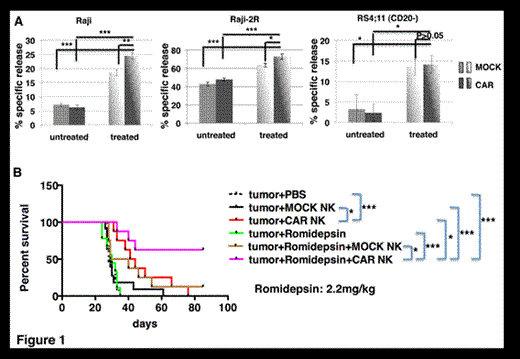Abstract
Background: The outcome for patients with Burkitt lymphoma (BL)has improved significantly but for patients who relapse, the prognosis is dismal due to chemo-radiotherapy resistance (Cairo et al, JCO, 2012).Natural Killer (NK) cells play an important role in tumor eradication post allogeneic stem cell transplantation (Ruggeri, Science 2002). Our group has successfully engineered expanded peripheral blood Natural Killer cells (exPBNK) cells with an anti-CD20 chimeric antigen receptor (CAR exPBNK) to target relapsed/resistant CD20+ BL cells in vitro and in NSG mice (Chu & Cairo, ASH, 2013). Romidepsin, a histone deacetylase inhibitor, enhances NKG2D ligands expression (Satwani, Chu/Cairo, Cytotherapy 2014).
Objective: We investigated the combined effect of anti-CD20 CAR expanded PBNK cells with Romidepsin against CD20+ BL cells in vitro and in humanized NSG mice.
Methods: PBNK cells were expanded with inactivated K562-mbIL15-41BBL cells and purified. Anti-CD20-4-1BB-CD3ζ mRNA was produced in vitro and nucleofected into exPBNK (Chu & Cairo, ASH, 2013). CAR expression was detected by flow cytometry. Raji, Raji-2R and Raji-4RH (provided by Matthew Barth, MD) cells were treated with 10ng/ml romidepsin, provided by Celgene. MICA/B expression was analyzed by flow cytometry. NK cytotoxicity was assessed by europium release assays.
Humanized Raji xenografted NSG mice were established as previously described (Chu & Cairo, ASH, 2013). After successful Raji-Luc engraftment in mice at day 7, 2.2mg/kg romidepsin or PBS was i.p. injected to these mice. 5x106 anti-CD20 CAR exPBNK cells or MOCK exPBNK cells (without anti-CD20 CAR expression) were i.p. injected to each mouse 24hrs later after romidepsin injection. Romidepsin followed by exPBNK or CAR exPBNK therapy was given to each mouse once a week for continuous 3 weeks. Tumor regression and/or progression were monitored weekly by tumor volume measurement and by in vivo bioluminescent imaging.
Statistical probability of survival and comparison of survival curves were determined by Kaplan Meier Method and the log-rank test. The results with a P value < 0.05 were deemed statistically significant.
Results: MICA/B expression was significantly increased in rituximab sensitive Raji (Day0 vs Day1: 0.634+ 0.074% vs 47.7+1.04%; n=3, P<0.001), rituximab resistant Raji-2R (Day0 vs Day1: 0.472+ 0.091% vs 75.6+2.56%; n=3, P<0.001) and Raji-4RH (Day0 vs Day1: 0.187+ 0.0196% vs 69.33+0.841%; n=3, P<0.001) after romidepsin treatment.
In vitro cytotoxicity of ex vivo expanded PBNK (exPBNK) was significantly enhanced against romidepsin treated Raji, Raji-2R, and Raji-4RH compared to untreated targets at E:T=3:1 (6.3+ 0.38% vs 16.93+1.2%, P<0.001; 42.82+ 2.2% vs 63.44+2%, P<0.001; 61.78+ 1.01% vs 74.78+1.8%, P<0.001; n=4).
Blocking NKG2D in exPBNK significantly reduced in vitro cytotoxicity against romidepsin treated Raji, Raji-2R, and Raji-4RH compared to the unblocked exPBNK (P<0.001), indicating NKG2D and MICA/B are involved in the enhanced cytotoxicity in romidepsin treated BL.
In vitro cytotoxicity of anti-CD20 CAR modified exPBNK was further significantly enhanced against romidepsin treated Raji, Raji-2R, and Raji-4RH compared to untreated targets at E:T=3:1 (24.48+ 1.11% vs 6.28+0.85%, P<0.001; 74.75+ 3.34% vs 47.99+0.5%, P<0.001; 80.6+ 0.77% vs 68.9+1.8%, P<0.001; n=4), or compared to the mock exPBNK against romidepsin treated targets (24.48+ 1.11% vs 18.52+1.06%, P<0.01; 74.75+ 3.34% vs 66.65+2.34%, P<0.05; 80.6+ 0.77% vs 74.7+1.01%, P<0.05; n=4). Rs4;11 was used as another control (Fig.1A)
In humanized Raji xenograft NSG mice, the romidepsin+CAR exPBNK treated mice had significantly extended surviving time (over 60% mice surviving more than 100 days) compared to the untreated mice (median 28 days, P<0.001), the mock exPBNK treated mice (median 29 days, P<0.001), the CAR exPBNK treated mice (median 42.5 days, P<0.05), the romidepsin treated mice (median 30 days, P<0.001), and the romidepsin+mock exPBNK treated mice (median 34.5 days, P<0.05) (Fig.1B).
Conclusion: anti-CD20 CAR modified expanded PBNK cells significantly enhanced cytotoxicity against romidepsin treated rituximab sensitive and resistant BL in vitro and in vivo. These results indicate the therapeutic potential of the combination of anti-CD20 CAR modified exPBNK cells and romidepsin against BL disease in patients with chemo-radio therapy resistance.
Cairo:Celgene: Research Funding.
Author notes
Asterisk with author names denotes non-ASH members.


